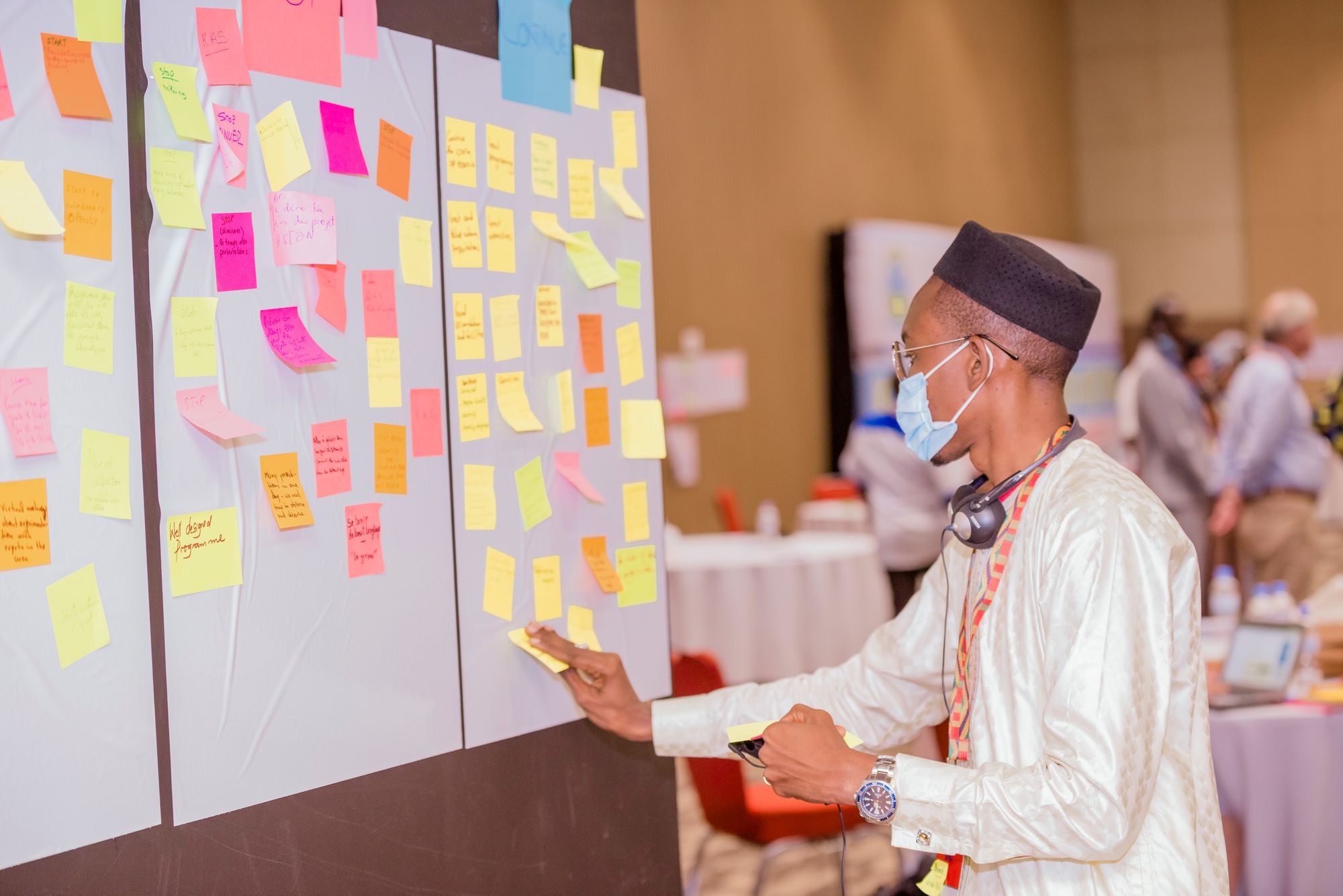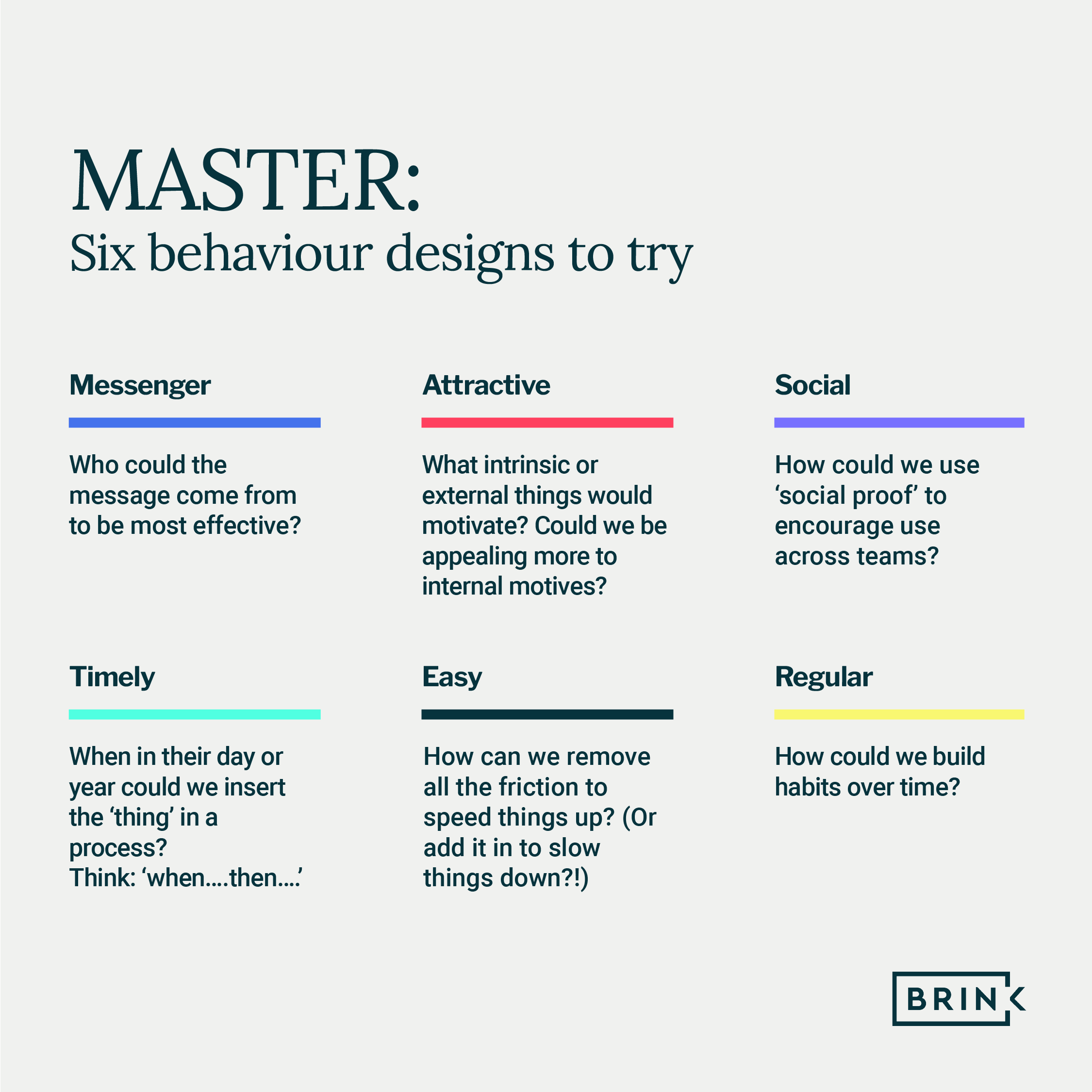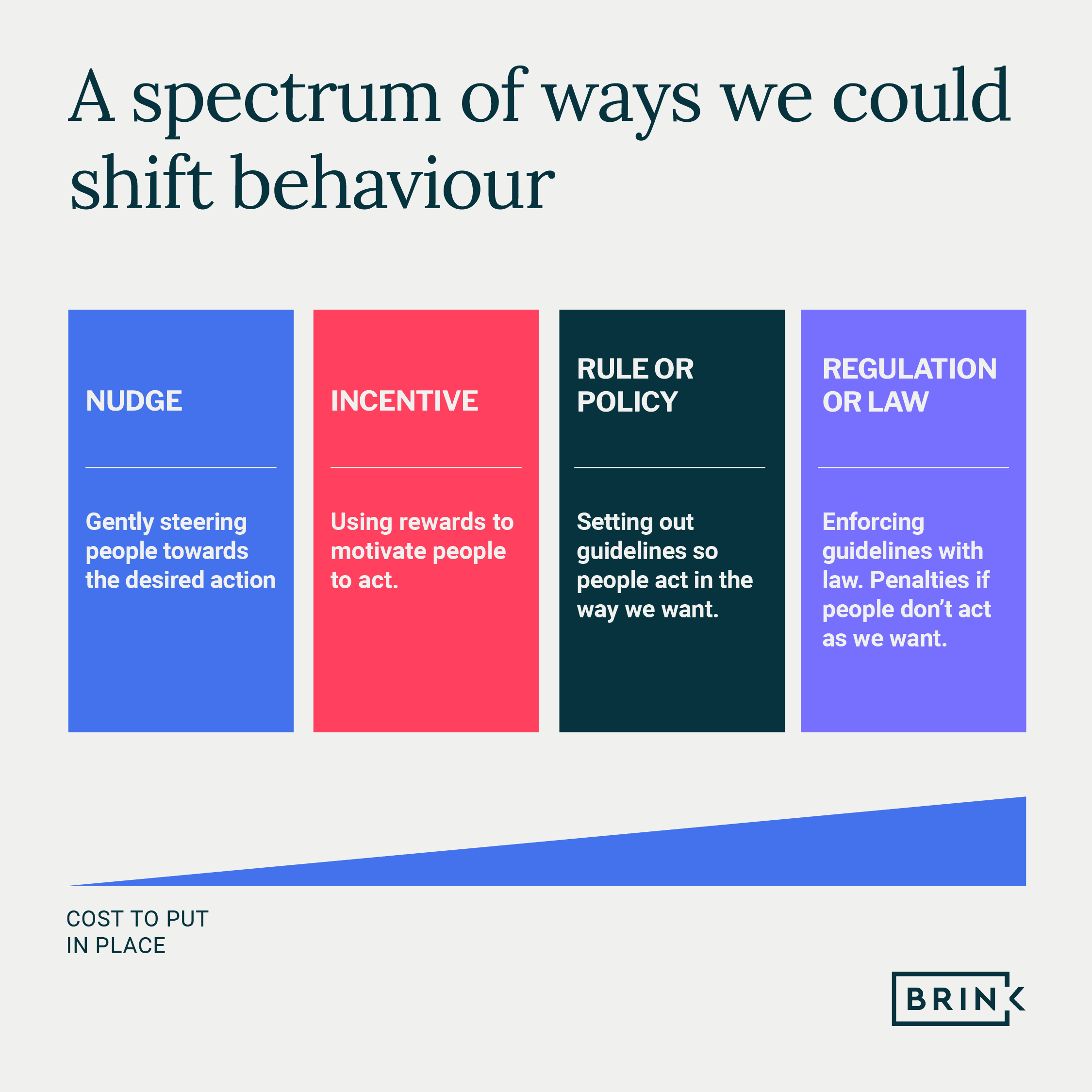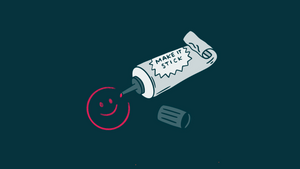
You're navigating a bustling airport trying to get your bearings, suitcase straining your arm. Suddenly, you notice a trail of subtle footprints printed on the floor, gently guiding you towards security. People naturally follow the lead of others, and these footprints subconsciously suggest "this is the way to go." Airports worldwide have adopted this strategy, subtly guiding passenger flow, and reducing congestion and confusion. This, in essence, is the power of nudges: small, evidence-based interventions designed to influence behaviour in a positive way.
Now, consider the challenges of achieving high-stakes innovation out in the real world. Whether it's humanitarian innovators working in conflict settings, healthcare workers trying new oxygen concentrators on newborns in rural hospitals, or teachers introducing new teaching methods to classes of over 100 pupils; navigating complex systems with uncertain outcomes can be daunting.
So how can we design environments that enable people to innovate (for example designing and testing new ideas and iterating them based on real world feedback) in those already complex, high pressure systems?
This is where behaviour design comes in. By understanding a little about our psychology and the things that influence our choices, we can strategically 'nudge' individuals and systems towards a desired outcome. It’s a way of cutting through the complexity and the uncertainty of these systems by starting with simple changes on the individual level which are cheap to implement and relatively easy to measure. If you're already thinking - who are we to decide what the desired outcome is and how people should behave? - then you're in the right place. Read to the end where we tackle this important question).
In the case of making effective change the thing we are nudging individuals and systems towards is the ability to innovate and experiment. The ability to come up with new ideas, test them in real-world settings, evaluate them, and then scale them if they're working or exit them if they aren't.
Introducing the MASTER framework
The MASTER framework serves as a practical guide for simple things you can do to enable innovation in the real world. It's a six-part prompt that helps us design enabling environments for people to try out new behaviours in small and safe ways, and eventually foster behaviour change in already complex, high-pressure systems.
MASTER is for you if you need to consider the environment innovators and changemakers are in, and how that environment might be enhanced to better enable experimentation, learning, problem solving and change.
When we talk about environment, this is in the broadest sense of the word - more than just physical environment, it's about the people and processes that are around, too. For teams and organisations the environment could include things like HR processes, procurement, digital tools the teams are using. For anyone working in real-world settings like a hospital ward or classroom, environment could include shift patterns, how people get paid or promoted, policies and regulations they must adhere to as well as the physical layout.
We have tested out the MASTER framework in hospitals and classrooms, with drone designers and data architects. We’d love for you to use it, too, and tell us how you found it.
So, how does MASTER work?
While it's a robust tool, it's important to acknowledge that real-world application is rarely linear. Often we need to iterate and adapt along the way. Still though, understanding the core principles empowers us to make informed decisions.

Let's delve deeper into each of the six prompts: M.A.S.T.E.R. For each we'll introduce the concept and how to apply it, give an example from our work or the world, and then give some prompt questions to think about when you try this out in your own work.
1. Messenger
People are more likely to be influenced by messages from trusted sources - we respond differently based on who a message or instruction is coming from.
- Apply it: Identify credible messengers who resonate with the target audience. This could be a community leader, a healthcare professional, or even a celebrity figure aligned with the initiative.
- Example: During a vaccine rollout campaign, partnering with trusted local doctors and religious leaders can increase vaccine uptake rates and address community concerns. On our work with the FCDO-funded Oxygen CoLab, grantees Sanrai are testing ways to improve use of concentrators and data collection in facilities in India and secured a telephone call from the Minister of Health to clinics mandating data reporting.
- Think about: Who is your message coming from and are they the most effective person to land what you need to convey? Who would your target audience respond to most favourably and most quickly? Who would inspire action? Who would legitimise tough decisions? It may be a person in a position of authority, it may be 'someone like us'. Notice any local cultural approaches to authority, safety, trust and power.
2. Attractive
We are all more likely to do something if we find it appealing and it offers clear benefits. What we find rewarding differs from person to person - we each have our own unique blend of internal and external motivations, or incentives, which you can read more about here. A person's internal motivations could be things like saving lives, providing good livelihoods for communities, or being proud of their impact on the climate crisis. These tend to be intrinsic drivers where the feeling of reward stems from altruism, pride, achievement, protection or community. External motivations could be things like earning money, preventing financial losses, others' favourable opinions, or gaining kudos and recognition. These tend to be extrinsic drivers where the feeling of reward stems from material or reputational gain.
- Apply it: Frame the desired behaviour change in a way that highlights its positive rewards and personal relevance. Think beyond tangible benefits and consider intrinsic motivations like community connection or personal growth. The first thing people tend to think of to make taking the risk of innovation more attractive is a prize or even cash, but these can backfire and actually discourage innovation.
- Example: In a classroom setting, encouraging innovation that improves the experience of students and colleagues is much more likely to lead to sustained success than giving a prize to the person with the best idea. Sure, prizes can work, but more as a one-off.
- Think about: What other internal or external motivations can you think of and which is most appropriate to prioritise for your situation? What are the incentives in the system you’re looking at? Are they internal for people or external? This is sometimes called intrinsic or extrinsic motivation. How might you design for a blend of both types?
3. Social
As humans we are social creatures, influenced by the behaviours and attitudes of others around us, especially people like us or people we aspire to be like.
- Apply it: Leverage social norms or even peer pressure to promote the desired change. This could involve showcasing success stories, highlighting the growing number of individuals adopting the new behaviour, or fostering a sense of collective responsibility.
- Example: We were fortunate to work with 11 city mayors and their teams in the Africa Smart Towns Network (ASToN). Each city was developing and testing a digital tool or service for their city. By being in a cohort of people like them and going through a 3 year learning-and-doing programme together the city teams shared how they'd been able to move faster, think bigger and go further by seeing how others were doing alongside them.
“Seeing examples and what other cities are doing helps us to put together a strategy and a vision for us” – Omar Aninho Bay of Matola City Council
- Think about: How can you leverage peers’ opinions? How might you make the unseen, seen? For example, would a dashboard or even scoreboard be appropriate here to show how many others are already doing the thing you are trying to encourage?
4. Timely
Context matters. We are much more likely to create a change or build a habit if it’s delivered at the right time and in the right place. We are particularly affected by scarcity whether it be time running out, available places for participants running out, or a deadline after which an opportunity is no longer available. We are at our best when we hang a new behaviour onto an existing timing. e.g. when I clean my teeth in the morning then I take my medication.
- Apply it: Identify opportune moments to nudge people towards the desired behaviour, whether it be contributing new ideas to solve a problem, experimenting or pausing to evaluate what's happened so far. This could involve strategically placing reminders, providing feedback during specific decision-making processes, or capitalising on existing events and trends. By hanging it on to an existing habit we create a 'when...then...'.
- Example: With 2024 being Super Election year of over 64 national elections worldwide, having a deadline to register to vote will spark a significant uptick in people registering. To increase voter registration, setting up registration booths at convenient locations during community events can capture people at a time when they are more likely to be engaged and sign up. In California they have 'motor voter' which is the ability to register to vote when you are registering for your driver's license, something that's a rite of passage for most teenagers. When I get my drivers licence then I register to vote.
- Think about: How does the new behaviour you’d like to introduce interact with what already exists? What existing behaviour can you hang it on to? What's a 'when...then...'that might work? What existing event can you align it with? How might you create scarcity and spark action with a deadline?
5. Easy
Reducing friction and simplifying the process increases the likelihood of individuals adopting and sustaining the desired behaviour.
- Apply it: Design interventions that are user-friendly, accessible, and require minimal effort. This could involve automating tasks, providing clear instructions, and removing unnecessary steps or barriers. There's a whole world of defaults to dive into if you're interested.
- Example: In our ASToN work with Matola City Council we learned that streamlining the process of filing taxes by offering pre-filled forms and user-friendly online platforms, and by bringing digital devices out to neighbourhoods and markets for people to access them easily can increase the number of residents filing their taxes on time and accurately.
- Think about: What’s the ONE THING you need people to think, feel, or do? What are the defaults? How do you make it easier to stay in than to opt out? What is the Call To Action? How can you remove all the friction?*
* Note that sometimes it’s good to keep or add in friction. For example in the UK, to buy cigarettes they are now behind the counter hidden in a cupboard. Buying cigarettes is a process that has friction in it to try and deter people from buying them. It is still relying on nudges when legislation could have more effect - more on that, at the end of this article.
6. Regular
Ultimately, we are all creatures of habit. The more something happens regularly, the less brain space it takes up thinking about when to do that thing and the easier it becomes to just do it.
- Apply it: It’s best to start small and build up a rhythm. That way there are frequent rewards and feedback loops which trigger a dopamine release and encourage us to keep going. From there you can begin to add in more asks and tasks
- Example: In some recent research Brink team and partners Laterite and Procol Africa were doing on the Future of work in Kenya for TRANSFORM (Uniliver, EY, FCDO), the team held regular open meetings to share their findings, convene the sector and gather feedback. By holding a regular rhythm people knew what to expect and how to participate, and heard regular feedback on how their contributions had helped build a rich picture of the ecosystem (likely triggering a dopamine release of reward). Over 60 participants joined in and by the end of the work the research team had heard from over 700 people across the ecosystem.
- Think about: How can you create a regular rhythm for this to stick? What rhythm and frequency will you use to set up the habit? How will you create feedback loops or reward loops to trigger a dopamine release?
Tying it all together, you have Messenger. Attractive. Social. Timely. Easy. Regular. These are the core elements of the MASTER framework.
They can be used one at a time or all at once - there is no set order to use them in. Think of it more like a toolkit to pick from. Select a tool, try it, if it's effective keep going and if not, try something else. You may want to play with 2 or 3 in combination but it's certainly not the kind of framework where you must use all the elements. Sometimes a certain element won't be relevant and that's totally fine.
Proceed with caution!
There is a whole spectrum of ways we can shift behaviour. From cheap to implement nudges, to incentives and behaviour designs like setting certain defaults, right up to policy changes, regulations and laws (with enforcement to enact them). Nudges like the ones outlined above are quick and cheap to implement but can be more difficult to enforce as they are by design optional. They also open up a whole raft of ethical questions it's important to address in any behaviour design.

Most importantly, who gets to decide when we need to change behaviour? Who says what is ‘best’? There is much debate in behaviour design about this and rightly so. Approaches range from highly paternalistic cultures to more laissez-faire. It’s a big responsibility to decide what behaviour is optimal and to start persuading others they should be doing a certain thing. It's not to be taken lightly.
Even doing nothing is a decision in itself, sometimes the decision to not shift behaviour can be even more controversial. Smoking is a good example of this. Is it better to leave people to their own devices and smoke if they want to, or should the state intervene to limit access to cigarettes? Are people really freely choosing to smoke or are the tobacco companies' billion-dollar budgets and marketing teams persuading them? What is best, and who decides? And when is a Nudge actually a shove?
From there, if we are going to shift behaviours, how do we design so no one is left behind? Should you test with one group and leave a control group untouched? Think about working with vulnerable people in healthcare, or with schools. If the thing you’re going to be testing is potentially highly beneficial, is it okay that you’re only testing on a small subset of people to begin and leaving others out?
And finally, do people have a right to know you are influencing them?

It takes a sensitive and start-small approach to use nudges well. What works in one context may not translate to another but it's only by testing in the real world and taking the ethical matters into consideration that we can find out.
By harnessing the power of nudges and using the MASTER framework as a practical guide, we can navigate real-world complexities and design enabling environments that foster positive behavioural change. While not a one-size-fits-all solution, MASTER offers a valuable tool for navigating the complexities of creating lasting and impactful change.
I hope you enjoy testing it out with your teams and on your projects, and we'd love to hear how you get on with it and are very open to any ideas to improve it that you have. Talk to us, and let's keep testing and learning together.
Further reading:
Because we've mentioned airports we thought you might like to know there's a whole heap of nudges going on in airports and not all of them are in your best interests
A deep dive on the messenger effect in Messengers by Stephen Martin and Joseph Marks
More on the power (and secrets) of incentives
Research genius Uri Gneezy with his team Stephan Meier, and Pedro Rey-Biel dig into when and why incentives (don’t) work to modify behaviour, (2011)
The godfather of Nudge, Cass R. Sunstein on Nudges vs shoves (2014)
Carla Fried asks - Are Nudges cost effective (2018)





